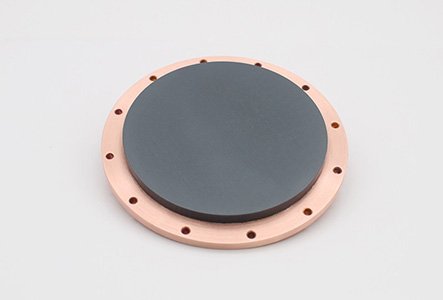Target Bonding
Target bonding is the process of attaching a sputtering target to a backplane using a thermally and mechanically stable bonding layer. This is a critical step in the preparation of sputtering targets, especially those used in high power or high temperature deposition systems.
Bonding ensures optimum thermal conductivity, mechanical support and operational safety during thin film deposition.
Why is target bonding essential?
Many high-purity and fragile targets (e.g., ceramics and some metals) are prone to cracking or delamination under thermal stress or mechanical shock. Target bonding helps:
Enhance heat dissipation during sputtering
Improve the mechanical stability of fragile targets
Reduce the risk of arcing, cracking and premature failure
Extend target life and improve process consistency
Ensure uniform film deposition and stable plasma performance

Backing Plate Selection
Material Requirements
Common backing plate materials include oxygen-free copper (OFC), stainless steel, and molybdenum. The typical thickness ranges from 2 to 3 mm.
Good Electrical Conductivity
Oxygen-free copper is widely used due to its superior thermal and electrical conductivity compared to standard copper.
Sufficient Strength
If the backing plate is too thin, it can easily deform and fail to achieve proper vacuum sealing.
Structural Options
Backing plates can be either solid or designed with internal cooling channels, depending on the application.
Optimal Thickness
Around 3 mm is generally ideal—too thick may reduce magnetic field strength, while too thin increases the risk of warping.
What target bonding methods we offer?
1. Clamping (Mechanical Pressing)
This method uses pressure bars and often includes materials like graphite foil, lead (Pb), or indium (In) foil to improve contact. However, this approach is rarely used today due to poor reliability and low market acceptance.
2. Soldering (Brazing)
Soft soldering is the most common method, especially with indium, tin, or In-Sn alloys. It provides good thermal conductivity and is typically used when sputtering power is below 20 W/cm². It’s especially effective for improving heat dissipation in ceramic targets.
3. Conductive Silver Epoxy
Used when higher sputtering power is required and traditional indium solder cannot withstand the heat due to its low melting point. Silver epoxy can endure high temperatures and is applied in very thin layers (0.02–0.05 mm). It’s typically chosen for special processes where higher thermal resistance is needed.
Our Advantages
✅ Comprehensive compatibility
We support Planar targets, rotating (tubular) targets and complex shapes for metals, ceramics and composites.
✅ Clean room target bonding environment
To prevent contamination and ensure bond integrity, our bonding operations are conducted under controlled cleanroom conditions.
✅ Precision Matching
We ensure that the thermal expansion between the target and Backplate is precisely matched to avoid warpage or delamination during use.
✅ In-house processing and inspection
All steps, from sheet preparation to final quality control, are carried out in-house under strict quality control to ensure traceability and repeatability.
✅ Bonding + Unbonding Services
We also offer unbonding and re-bonding services for customers who wish to reuse Backplates or replace targets.
✅ Global Support and Fast Delivery
We offer international bonding services with short lead times and quick response technical advice.
Why does Backing Plate Separation?
Excessive Sputtering Temperature
High temperatures can oxidize and warp oxygen-free copper. Ceramic targets may crack under thermal stress, leading to delamination.
Excessive Current
High current can cause rapid temperature rise. If the solder melts unevenly, it may result in poor bonding and eventual separation.
Inadequate Cooling
If the outlet temperature of the circulating cooling water exceeds 35°C, heat dissipation becomes inefficient, increasing the risk of delamination.
Typical Applications
Semiconductors and microelectronics
Display Technology (OLED, LCD, LED)
Optical and decorative coatings
Photovoltaics (solar cells)
Data storage (HDD, Blu-ray)
Have a target that needs bonding? Let our experts help you select the right Backplate and bonding method to maximise performance and reliability.
Contact us today to discuss your project!
Contact us
More Information
- PHONE:+86-29-88993870
- WHATSAPP:+8618291498609
- E-MAIL:sales@funcmater.com
- ADDRESS:A11, 5th Floor, Building 5, Digital China Xi’an Science Park, No. 20 Zhangba 4th Road, High-tech Zone, Xi’an, Shaanxi, China.

